My name is Tamara Grominsky. And I'm really excited to talk to you about the power and impact a good product marketing team can have on your business. I’ll also be sharing some of the insights I've gained through experience.
This can be a difficult topic to navigate, but I’m gonna break it down into a few key talking points:
Main talking points
- About me & Unbounce
- Confusion across teams
- Defining your role
- Creating your mandate
- Positioning your team
- Building alignment

About me & Unbounce
Unbounce is a powerful landing page builder for small to midsize businesses. We've fine-tuned the conversion path and managed to facilitate an amazing 1 billion conversions! 💪
I'm the VP of strategic growth, so one of my main duties is leading the product marketing team. I'm super passionate about small to midsize businesses! But I’m particularly interested in the SaaS products that exist to enable them.
Some of my previous experience includes leading product at FreshBooks, as well as at Yellow Pages, Canada. I'm also the Vancouver Canada ambassador for the Product Marketing Alliance. After All of my experience leading product marketing and growth teams, I started to understand that product marketing is one of the most underutilized and misunderstood functions out there.
That's really a shame because I believe that product marketing is one of the most critical functions in any fast-growing SaaS business. In fact, I would go as far as to say: 👇

In this article, I'm going to show you how you can implement a strong product marketing team in your own business.
But first, let’s look at some of the challenges that a good PM team can solve.
Confusion across teams
This really creates disjointed strategies as well as disjointed customer experiences. Unfortunately, this is a pattern that's very common at many SaaS businesses. It also leads to disjointed customer experiences.
So, imagine a scenario like this, your marketing team has just published an amazing lead gen piece. But your partnerships team has just signed this new, awesome partner who's in the automotive space.
Meanwhile, your product team is building new features for the realtor segment. Your sales team has just crushed this amazing new sale of a huge enterprise company that has 50 users. All of these teams think that they're doing an amazing job. What’s wrong with this picture? They're all focused on a completely different strategy.
This is a complete mess! Every team is moving in their own direction, and you never create any momentum.
How to synchronize these teams
To fix this, you need to think about plotting all of these teams just a little bit differently. Beginning from the top and working clockwise down, let’s begin with….
Marketing
Their job is really to attract new prospects and trailers to the business. They’re your first port of call. As I’m sure you know, first impressions are everything!
Sales
Their job is to convert and onboard those brand-new customers. You want to ensure that there is clear communication between marketing and sales. You don’t want customers to feel undervalued once you’ve got them through the door.
Customer success
They want to make sure that we're delivering customer value throughout the entire customer lifecycle. Ensuring a smooth customer onboarding journey is really their bread and butter, and they should really be consulted every step of the way!
They want to make sure that we're delivering customer value throughout the entire customer lifecycle. Ensuring a smooth customer onboarding journey is really their bread and butter, and they should really be consulted every step of the way!
Partnerships and business development
We’re always looking at developing relationships, and expanding the ecosystem of partners who could provide value to customers.
Product management
They’re really focused on building products that solve customer problems.
But, here’s the thing, if each of these teams are going in a completely different direction, you're never going to get alignment. That's why I believe that product marketing should really live in the center of this wheel.
When you have product marketing at the heart of your business and at the heart of your strategies, you can make sure that everyone is aligned. You're building holistic growth strategies, and you're streamlining tactics across the organization. This is what's actually going to create that momentum for you, and accelerate your business growth. 💪
The cost of misalignment
But when when you don't have that, this is what happens
- You're getting something that's being built for small businesses, but your sales and marketing teams are actually marketing to larger businesses.
- You're going to implement something like a short trial duration, but customers need a long cycle.
- You're just gonna be solving a market problem that your customers don't already have.
While each individual team might think that they're being successful – they might even be meeting their KPIs – It's not always clear what's going on around them and what all the other teams are doing.
When positioned for success, product marketing can create these growth strategies and really make sure that we're avoiding missteps like this.
Next, let's dig into the real meat of this article: four simple steps to experience the power and impact of Product Marketing.
1.Defining your role
In the old world, product marketing was really all about:
- Writing value propositions.
- Producing some marketing materials.
- Building some sales enablement for sales.
- Hosting webinars and demos.
Sounds pretty dull and limited, right? Well, the new world of product marketing is more strategically led. The aim is to:
- Understand the market and the competitive trends that are happening around us.
- Develop revenue and growth strategies that will fuel the business.
- Influence the product roadmap and drive the go-to-market strategy.
- Understand the value of the product.
- Ensure that customer is seeing value.
Note, we're no longer just bystanders waiting to be handed something to put on the shelf. I believe that really a definition of what a product marketing team should now be to: 👇

If we were to plot the different responsibilities of a product marketing team on a spectrum, we might split them into two categories: Strategy and Execution.
Strategy
- Marketing & competitive analysis.
- Opportunity sizing, and business cases.
- Pricing and monetization.
- Positioning and messaging.
If your team is strategically focused, you're spending a lot of time developing those inputs, and then using them to guide the GTM planning. At this point, this is probably when you're handing off the execution to another really strong team, like your customer marketing team or your marketing team.
This is all part of a spectrum that leads into…
Execution
- Content creation.
- Lead generation.
- Sales enablement.
- Customer activation and adoption.
If they're an execution-focused product marketing team, you probably have a different team giving you those strategic inputs. Maybe you're involved a little bit, but perhaps it's an actual strategy team at your organization who's doing this, or maybe it’s product management themselves.
I just want to be clear that there's no right or wrong place to fall on the spectrum. It's all about what makes sense for your team and your business. It's just really important that you are clear about where you want to fall on the spectrum.
In my opinion, the most effective product marketing teams are ones that skew towards the strategic side.
2. Create your mandate
But the most crucial thing is to create and share your mandate so that everyone else knows what you're working on as well.

When we think about product marketing, there's so many different things you can be doing that it can be a little bit overwhelming.
That’s why defining your mandate and really shaping what you're going to be doing is critical before you jump into it. We all kind of know the final destination we want to get to, we want to get to business growth. But there's a tonne of different ways and paths for us to get there.
At a tech startup, these possibilities are really endless. And it might be dependent on the stage of growth at your app, it's up to you to really identify where the biggest gap is that your team can fill.
Prioritizing all of the things
When it comes to prioritizing your mandate, I like to take a look at everything that we could be working on and then start to prioritize everything.
The first question you should be asking yourself is, what's the biggest business challenge that you’re struggling with right now?
- Are we struggling to attract leads?
- Do we need to increase our conversion rate?
- Are we actually looking to decrease churn?
- Segmentation.
- Differentiation.
- Pricing and monetization.
Now more than ever, it’s a really important time for you to take a look back and ask if your product marketing team is serving your organization for what it needs today.
Once you have an understanding of maybe the top three business problems that you need to solve, then you can start to think about how the product marketing team itself can plug into that.
- What's the most urgent out of all of these business problems?
- Does one need to be solved today?
- Is there sequencing that needs to happen here?
- Maybe the second problem is actually the most important?
- Finally, what is your team uniquely qualified to do?
This is where I think product marketing is really exciting! Product marketing is different at every single organization because of the compilation of the players on the product marketing team.
You and your team are going to have unique strengths. As individuals, you can utilize that to really positively impact your business. This should help guide the things that you're focusing on. Once you understand exactly the challenge that you want to face first, you can really start to get focused and get started.
Choosing your KPI
You want to make sure that everything that you're doing can be measured. That way, your team, and the organization can understand the impact you're having on the company.
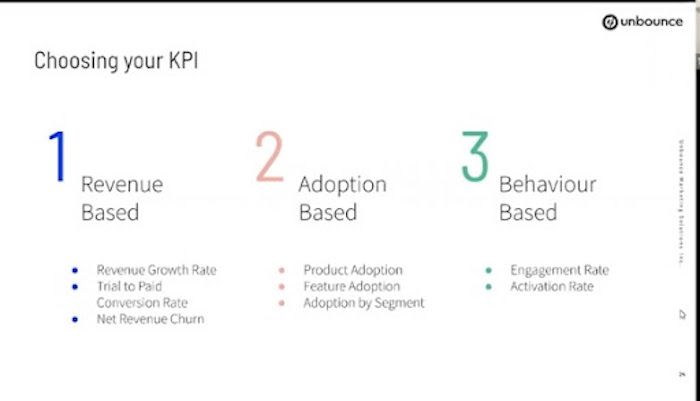
When I think about product marketing metrics, I like to think about them in three different categories. This may or may not be true for your business.
1. Revenue- based KPIs.
These will cover:
- Revenue growth rate,
- Trial to pay conversion rate,
- Net revenue churn.
These are actual metrics that probably several people around the business are also tracking, but you can be a key influencer.
2. Product adoption based metrics
These are things usually related to product launch, but they could be carried over after product launch as well. So, thinking about initial product adoption:
- What is the adoption rate that you want, within three months of launching, or within one year?
- What's the adoption rate you want per segment or per use case?
- Is it really important to you that you drive usage of a particular feature?
- Do you have key segments that you're going after?
3. Behavior-based KPIs
This is really about how customers and users are engaging with your tool. What is that one metric that can show you that customers are highly engaged? You can also think about activation rate. How do you know when a customer has really reached that initial point of value, and they can be considered activated.
There are tons of activities that could go along with these behavior-based KPIs. But they're often things that not a lot of people in your organization are focused on. So, if you can focus on them, you can make a lot of improvement.
3. Position your team
Once you understand what your mandate is, and the types of problems you're going to solve, you really need to think about where your team should sit within your organization.
Now, this is a really controversial topic, but it can really be boiled down into this question:
Should Product Marketing sit in product or in marketing?
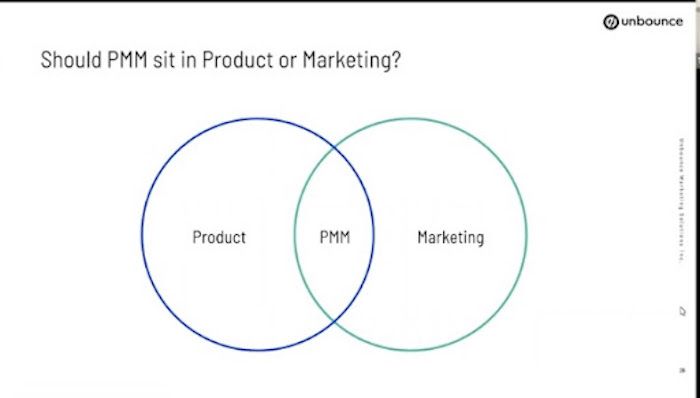
Really, there's benefits to both. But the truth is, it's not that simple. This is really an oversimplified view of the question we should be asking ourselves.
Product marketing doesn't just enable marketing and product management, It enables a handful of teams across the entire organization. I would argue that putting product marketing and marketing together or lumping product marketing in with product management really cuts out the value it could provide to the other teams.
Let's take a closer look at product marketing and product management and the different teams they enable.
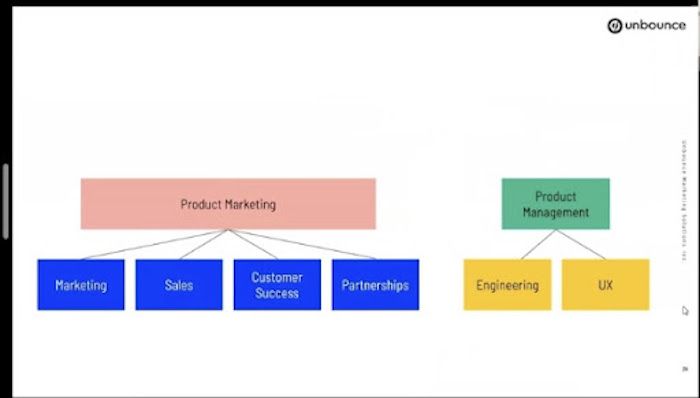
With product marketing the key stakeholders are:
- Marketing.
- Sales.
- Customer success.
- Partnerships.
On the flip side, product management is usually responsible for the relationships with engineering and UX.
Together, product management and product marketing form a partnership to make sure all of these teams are on the same page.
So, for the purposes of this article, let’s really focus on product marketing.
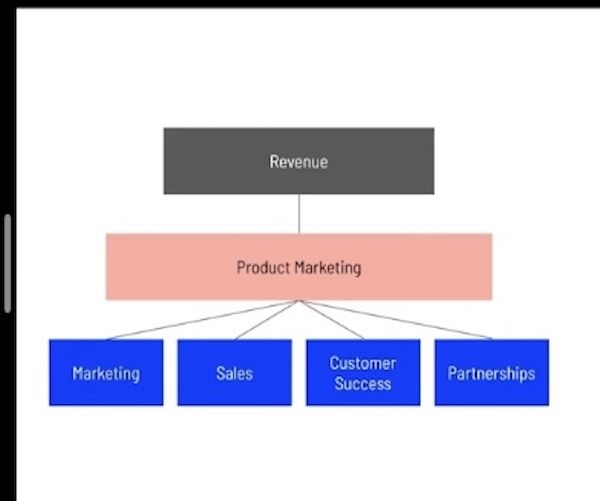
What do all of these four blue teams have in common? They're all revenue-focused teams. I would urge you to think outside of the box of where product marketing could fit, and consider, could it fit in a revenue department?
At Unbounce, this is what our structure looks like. 👇
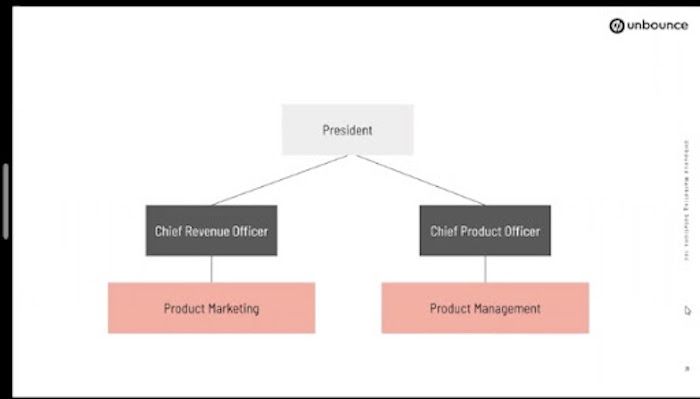
I report directly to our Chief Revenue Officer. Our product management team reports to each product officer. Both of those departments report to the president.
In this way, product marketing and product management can really be peers and partners, and represent both halves of the business.
Now, obviously, not every company has a chief revenue officer, not every company has a revenue department. But what I really just want to communicate today is the fact that there are other options out there.
Why do we sit in revenue?
Why do we make that distinct separation? Well, first of all, it really creates an unbiased, neutral team. In product marketing, we really understand both sides of the business. And when we're making decisions, marketing doesn't feel like we're making it just because we sit with product management.
Product management doesn't think that we're making it just because we sit with marketing, because we're outside of both of those teams. And so we can see the benefits of every decision that we make.
It also makes sure that product marketing is seen as a key function and a department, it's not a sub function of another team.
It also allows for streamlined communications between both sides of the business. Because we are able to represent the side of all of the different revenue teams to product management, we get a more holistic view of the conversation. We set it up this way to create strategic alignment and build momentum.
There are, of course, other structures that exist. The most typical option is to sit within marketing or product management. And there are benefits of these as well.
The benefit of marketing
You're sitting super close to copywriters, who are able to really help you tweak your positioning and messaging and get that content out in the market. It also means that product marketing usually will have a deeper understanding of the buying journey, and the top of the funnel.
The benefit of product management
The benefit here is that your typical closest stakeholder is product management. Sitting within that department means that you're creating even more alignment than if you would be separated. it also means you would be defaulted into being involved in the entire product development lifecycle from ideation onwards, and this can be a tricky one for many product marketing teams.
It doesn't mean that if you're not in product, It just means that if you're baked into the team, You're baked into that process.
To reiterate, there's no right or wrong answer to that one. But what’s important is that you're having the conversation with senior leaders and decision makers across the organization. You're deciding what makes sense based on your goals and your team.
4. Build Alignment
Now it's really time to leverage the team that you've put together to create some alignment across the entire organization. Hopefully where you've decided to sit in the organization is going to help you do this.
So, it's really our job at this point to align the efforts of a lot of other execution-focused teams, especially if you're a strategic product marketing team.
Collect feedback and inputs
This is not just a product strategy, and it’s not just the GTM strategy, but a holistic strategy to grow the business.This means that you’re taking every department into account when you’re plotting your strategy. When it comes to collecting feedback and inputs, it's really important that you're building rituals with your core teams across the company.
So again, think about partnerships, think about sales and customer success. Creating these rituals will build open lines of communication between both product marketing and those customer facing teams. They're on the front lines talking to customers day in and day out.
And so it's really important that you're getting that feedback loop. But you want to make sure this isn't just being told to you ad hoc, you want to centralize this customer user feedback, so everyone across the organization can access it and make decisions against it. This also means that if all of the information is in one place, you're able to actually identify trends and patterns as time goes on.
Build product and revenue strategy
But when it comes time to build the strategy, It's your responsibility as a product marketing team to bring all of the collected feedback to your product management partners.
You don't want to just bring them information, you want to bring them insights. And then together you want to build one holistic strategy. And the reason this is so important is that if you have a product strategy and go to market strategy, if they're not one strategy, you're never going to build that momentum or build that acceleration.
Again, at the end of your strategy, you want to define what success looks like for everyone, not what success looks for each part of the business or each team. How will we know if we've executed on our strategy successfully, and what are the one, two or three key metrics that we're going to track collectively to make sure we hit that goal?
Product marketing and product management are responsible for building the strategy, but you're not building it alone. Remember all of the stakeholders that you have.
To wrap up: let’s execute
Remember all of the stakeholders you have, remember all of the inputs you have, you need to make sure they're bought in throughout the journey. By the end, once they're ready to start execution, they should be just as excited as you are.
Take the time to help the other teams understand how they can contribute what it means for them on a day to day basis. And then take a step back and actually empower them to do what they do best.
Remember, we talked about how your team should be strategically focused? Well, now is the time for those execution-focused teams to execute on that amazing strategy.
You want to make sure you're coordinating with all of the different teams to make sure they're on the same page throughout.
Empower your teams to execute!

